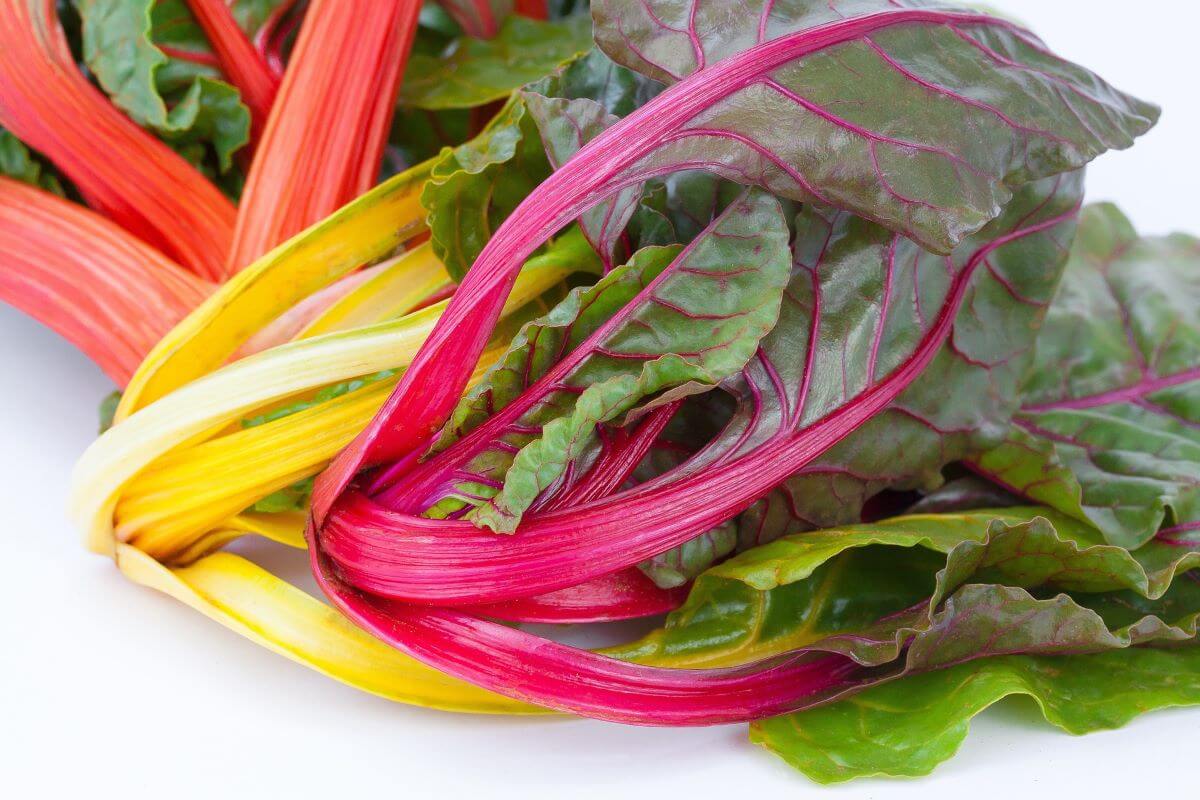
Growing Swiss chard in your home garden provides you a bountiful supply of leafy, cool-weather greens. Planting them can even beautify your space, showcasing bright colors of orange, purple, and red, from their colorful stalks.
A close member of the beet family, Swiss chard (Beta vulgaris subsp. vulgaris) has nutritious leaves with differing textures, depending on the variety. Other names for Swiss chard include beet spinach, leaf beet, perpetual spinach, and silver beet. This biennial plant can be enjoyed in a number of dishes and harvested early as baby greens.
Common Swiss Chard Types
Swiss chard is a leafy vegetable that can be categorized into two categories. The Flavescens group is characterized by their sizable, thick stems, which are often prepared separately for cooking separately. Leafier Swiss chards fall under the Cicla group, which can be used interchangeably with spinach.
Heirloom and Hybrid Swiss Chards
Barese Dark Green Smooth Leaf, Bright Lights, Fordhook Giant, Large White Ribbed, Lucullus, Magenta Sunset, and Ruby Red are some of the most popular heirloom Swiss chards. A certain plant variety should be at least 40 to 50 years free from cross breeding to be considered heirloom. Due to their true-to-seed nature, heirloom varieties are exceptional for seed saving as they carry the same traits from the parent plant. These have been passed down from generation to generation among various ethnic, familial, or other social groups. Additionally, private institutions like seed companies and universities participate in maintaining certain Swiss chard seeds as heirlooms.


Hybrid varieties are results of deliberate cross breeding between two Swiss chard varieties. Agriculturists can tweak and imbue certain traits into the new hybrid. Improvements on disease resistance, flavor, growth, pest resistance, size, yield, and other characteristics are possible among hybrid varieties.
Popular Swiss Chard Groupings
Read on to discover the many Swiss chard groupings by color, texture, flavor, geographic origin, culinary uses, disease resistance, and growing conditions.
Types of Swiss Chard Stalk Colors
There’s a rainbow of colors when it comes to Swiss chard stalks.
Types of Swiss Chard Leaf Textures
When consumed raw, the savoy leaves of Swiss chards can add crunch and texture.
Types of Swiss Chard Flavors
Generally, raw Swiss chards have a bitter, earthy flavor that slowly fades during cooking.
Types of Geographic Origins
The oldest record of Swiss chards can be traced back to the Canary Islands and Mediterranean regions.
Types of Culinary Uses
Fresh Swiss chards can be used in salads, soups, stews, and stir-fry. Swiss chard leaves are commonly a substitute for other leafy greens: cabbage, kale, and spinach. You can also chop the stalks and steam or sauté them.
Types of Disease Resistance
Some cultivars of Swiss chard are more resistant to disease than others. Plant diseases to watch out for include bacterial soft rot, cucumber mosaic virus, and powdery mildew.
Types of Preferred Growing Conditions
Home gardeners with limited garden space should consider Swiss chard varieties suitable for container planting. A well-drained soil with a pH balance of anywhere between 6 and 6.4 is the most ideal when growing Swiss chard plants at home.
Popular Varieties of Colorful Swiss Chards


These Swiss chard varieties can produce stems with varying colors. Apart from their culinary uses, these Swiss chards add beautiful pops of colors in your vegetable garden as ornamental plants.
| Variety | Description | Days to Germination | Days to Maturity | Where to Buy |
|---|---|---|---|---|
| Bright Lights | Bright Lights Swiss chard is an All-America Selections winner from 1998. Expect crisp Swiss chard stems of varying colors from orange, pink, red, violet, white, and yellow. The savoy leaves can turn out either green or purple, and work well in recipes or as a garnish. | 5 to 7 days | 60 to 65 days | Territorial Seed Company |
| Colour Mix | This variety of Swiss chard provides diversely colored stems and tender leaves, adding a visual flare to your garden and meals. Colour Mix yields green-, red-, white-, and yellow-stalked Swiss chards with either green or red leaves. | 7 to 14 days | 60 to 65 days | Territorial Seed Company |
| Electric Neon Blend | The stalks in the Electric Neon Blend variety come in four colors: orange, pink, red, and yellow. The Swiss chard leaves from the Electric Neon Blend are consistently green. | 5 to 7 days | 60 to 65 days | Territorial Seed Company |
| Five Color Silverbeet | Also known as rainbow chard, the Five Color Silverbeet originated from Australia where it has been enjoyed for mild flavor and a colorful appearance. This variety is an excellent option for home gardening due to its uniformity, upright growth, and reliable crop. | 14 to 21 days | 60 to 65 days | Territorial Seed Company, Rare Seeds |
Popular Varieties of White-Stalked Swiss Chards


Most white-stalked Swiss chards tend to have light-to-dark green leaves that go well in soups, stews, and stir-fry.
| Variety | Description | Days to Germination | Days to Maturity | Where to Buy |
|---|---|---|---|---|
| Barese Dark Green Smooth Leaf | This Italian heirloom provides tender texture and spinach-like sweetness when cooked. Barese Dark Green Smooth Leaf can be harvested as baby greens or allowed to mature until they reach the height of 7 to 12 inches. | 14 to 21 days | 30 to 50 days | True Leaf Market, Rare Seeds |
| Fordhook Giant | Known for its tall height and wide growth spread, Fordhook Giant is an heirloom Swiss chard that could be the next great addition to your vegetable garden. Highly productive, this variety can reach 22 to 27 inches tall with delicious savoy leaves and white stems. | 7 to 14 days | 50 to 60 days | Eden Brothers, True Leaf Market, Rare Seeds |
| Large White Ribbed | Another productive variety, Large White Ribbed Swiss chard can grow as tall as 26 inches under ideal conditions. You can grow them in containers and even harvest young sprouts as baby greens. | 7 to 14 days | 55 to 60 days | Eden Brothers, True Leaf Market |
| Lucullus | Lucullus is one of the best Swiss chard varieties you can grow at home. You can get exceptional crunchiness from the white stems and flavor similar to spinach from its green, savoy leaves. | 7 to 14 days | 50 to 55 days | Eden Brothers, True Leaf Market |
| Lyon | Dubbed as the best-tasting Swiss chard in Territorial Seed Company’s trials, Lyon grows light green leaves, reaching up to 12 inches long. | 7 to 14 days | 50 to 55 days | Territorial Seed Company |
FAQ About Types of Swiss Chard
Are beets and Swiss chard the same?
Swiss chards and beets are not botanically the same, but share a close relation. Traditionally, Swiss chards are grown for their stems and leaves, while beets are cultivated for their root crop.
Which Swiss chard varieties are excellent as microgreens?
If you’re looking for a fresh addition to your salads, consider Swiss chard microgreens. Apart from their distinct flavors, certain varieties can provide beautiful colors to your meal. Swiss chard varieties like Barese Dark Green Smooth Leaf, Pink Lipstick, Rainbow Mixture, and Ruby Red are suitable for an early harvest as baby greens.







